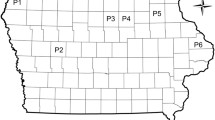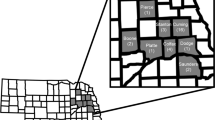Abstract
In Europe, Bt-corn resistant against the European Corn Borer has until now been the only genetically modified plant to be grown commercially. With the advent of the Western Corn Rootworm Bt-corn varieties with resistance against Coleoptera will become important. The cultivation of Bt-plants may have negative impacts on non-target organisms, i.e. all species not explicitly targeted by a given Bt-crop. One prominent non-target group in corn are the herbivorous plant bugs (Heteroptera: Miridae). They are common, abundant and exposed to the Cry-protein. We therefore assessed the potential impact of the cultivation of the Cry3Bb1-expressing Bt-corn variety MON88017 and three conventional varieties on this group. Trigonotylus caelestialium (Kirkaldy) was the most abundant plant bug at the experimental field. There was no evidence for a negative impact of MON88017 on this species, despite its considerable exposure to Cry3Bb1 demonstrated with ELISA. The conventional corn varieties, however, had a consistent and significant influence on the field densities of this species over all three growing seasons.



Similar content being viewed by others
References
AGBIOS database. http://www.agbios.com/dbase.php. Accessed June 2007
Ahmad A, Wilde GE, Whitworth RJ, Zolnerowich G (2006) Effect of corn hybrids expressing the coleopteran-specific Cry3Bb1 protein for Corn Rootworm control on aboveground insect predators. J Econ Entomol 99:1085–1095
Al-Deeb MA, Wilde GE (2003) Effect of Bt corn expressing the Cry3Bb1 toxin for Corn Rootworm control on aboveground nontarget arthropods. Environ Entomol 32:1164–1170
Árpás K, Tóth F, Kiss J (2005) Foliage-dwelling arthropods in Bt-transgenic and isogenic maize: a comparison through spider web analysis. Acta Phytopathol Entomol Hung 40:347–353
Dively GP (2005) Impact of transgenic VIP3A × Cry1Ab Lepidopteran-resistant field corn on the non-target arthropod community. Environ Entomol 34:1267–1291
Dively GP, Rose R (2003) Effects of Bt transgenic and conventional insecticide control on the non-target natural enemy community in sweet corn. In: Proceedings of the 1st international symposium on biological control of arthropods. Honolulu, Hawaii, USA 2002, USDA-Forest Service FHTET-03-05, pp 265–274
Duan JJ, Paradise MS, Lundgren JG, Bookout JT, Jiang C, Wiedenmann RN (2006) Assessing nontarget impacts of Bt corn resistant to Corn Rootworms: Tier-1 testing with larvae of Poecilus chalcites (Coleoptera: Carabidae). Environ Entomol 35:135–142
Duan JJ, Teixeira D, Huesing JE, Jiang C (2008) Assessing the risk to nontarget organisms from Bt corn resistant to Corn Rootworms (Coleoptera: Chrysomelidae): Tier-I testing with Orius insidiosus (Heteroptera: Anthocoridae). Environ Entomol 37:838–844
EC (2001) Directive 2001/18/EC of the European parliament and of the council of 12 March 2001 on the deliberate release into the environment of genetically modified organisms and repealing council directive 90/220/EEC. L 106/1 of 4/17/2001
EC (2002) Council decision of 3 October 2002 establishing guidance notes supplementing annex VII to directive 2001/18/EC of the European parliament and of the council on the deliberate release into the environment of genetically modified organisms and repealing council directive 90/220/EEC. L 280/27 of 10/18/2002
EFSA (2006) Guidance document of the scientific panel on genetically modified organisms for the risk assessment of genetically modified plants and derived food and feed. EFSA J 99:1–100
Glare TR, O'Callaghan M (2000) Bacillus thuringiensis: biology, ecology and safety. Wiley, Chichester, New York, Weinheim, Brisbane, Singapore, Toronto
Goto J, Higuchi H (2004) Preliminary evaluation of the flight ability of the rice leaf bug, Trigonotylus caelestialium (Kirkaldy) (Heteroptera: Miridae), investigated by tethered flight technique. J Appl Entomol Zool (Jpn) 48:219–224
Harwood JD, Wallin WG, Obrycki JJ (2005) Uptake of Bt endotoxins by nontarget herbivores and higher order arthropod predators: molecular evidence from a transgenic corn agroecosystem. Mol Ecol 14:2815–2823
Head G, Brown CR, Groth ME, Duan JJ (2001) Cry1Ab protein levels in phytophagous insects feeding on transgenic corn: implications for secondary exposure risk assessment. Entomol Exp Appl 99:37–45
Hummel HE (2003) Introduction of Diabrotica virgifera virgifera into the old world and its consequences: a recently acquired invasive alien pest species on Zea mays from North America. Commun Agric Appl Biol Sci 68:45–57
James C (2006) Global status of commercialized biotech/GM crops: 2006. ISAAA Briefs 35, ISAAA, Ithaca, NY
Kiss J, Szentkirályi F, Tóth F, Szénási A, Kádár F, Árpás K, Szekeres D, Edwards CR (2002) Bt corn: impact on non-targets and adjusting to local IPM systems. In: Lelley T, Balázs E, Tepfer M (eds) Ecological impact of GMO dissemination in agro-ecosystems. Facultas, Wien, pp 157–172
Kiss J, Edwards CR, Berger HK, Cata P, Cean M, Cheek S, Derron J, Festic H, Furlan L, Igrc-Barcic J, Ivanova I, Lammers W, Omelyuta V, Princzinger G, Reynaud P, Sivcec I, Sivicek P, Urek G, Vahala O (2005) Monitoring of Western Corn Rootworm (Diabrotica virgifera virgifera LeConte) in Europe 1992–2003. In: Vidal S, Kuhlmann U, Edwards CR (eds) Western Corn Rootworm: ecology and management. CABI Publishing, Wallingford, pp 29–39
Lumbierres B, Albajes R, Pons X (2004) Transgenic Bt maize and Rhopalosiphum padi (Hom., Aphididae) performance. Ecol Entomol 29:309–317
McCann MC, Trujillo WA, Riordan SG, Sorbet R, Bogdanova NN, Sidhu RS (2007) Comparison of the forage and grain composition from insect-protected and glyphosate-tolerant MON88017 corn to conventional corn (Zea mays L.). J Agric Food Chem 55:4034–4042
McManus BL, Fuller BW, Boetel MA, French BW, Ellsbury MM, Head GP (2005) Abundance of Coleomegilla maculata (Coleoptera: Coccinellidae) in Corn Rootworm-resistant Cry3Bb1 maize. J Econ Entomol 98:1992–1998
Miller N, Estoup A, Toepfer S, Bourguet D, Lapchin L, Derridj S, Kim KS, Reynaud P, Furlan L, Guillemaud T (2005) Multiple transatlantic introductions of the Western Corn Rootworm. Science 310:992
Nguyen HT, Jehle JA (2007) Quantitative analysis of the seasonal and tissue-specific expression of Cry1Ab in transgenic maize MON810. J Plant Disease Prot 114:82–87
Niiyama T, Fujii T, Hori M, Matsuda K (2007) Olfactory response of Trigonotylus caelestialium (Het.: Miridae) to rice plant and gramineous weeds. J Appl Entomol 131:513–517
Obrist LB, Dutton A, Albajes R, Bigler F (2006) Exposure of arthropod predators to Cry1Ab toxin in Bt maize fields. Ecol Entomol 31:1–12
Pons X, Lumbierres B, López C, Albajes R (2005) Abundance of non-target pests in transgenic Bt-maize: a farm scale study. Eur J Entomol 102:73–79
R Development Core Team (2007) R: a language and environment for statistical computing. R Foundation for Statistical Computing, Vienna, Austria. URL http://www.R-project.org/
Raps A, Kehr J, Gugerli P, Moar WJ, Bigler F, Hilbeck A (2001) Immunological analysis of phloem sap of Bacillus thuringiensis corn and of the nontarget herbivore Rhopalosiphum padi (Homoptera: Aphididae) for the presence of Cry1Ab. Mol Ecol 10:525–533
Rauschen S, Eckert J, Schaarschmidt F, Schuphan I, Gathmann A An evaluation of methods for assessing the impacts of Bt-maize MON810 cultivation and pyrethroid insecticide use on Auchenorrhyncha (Planthoppers and Leafhoppers). Agric Forest Entomol (in press)
Reeuwijk van LP (2002) Procedures for soil analysis. Technical Paper 9, 6th edn. ISRIC International Soil Reference and Information Centre, Wageningen
Romeis J, Meissle M, Bigler F (2006) Transgenic crops expressing Bacillus thuringiensis toxins and biological control. Nat Biotechnol 24:63–71
Schmitz G, Bartsch D (2001) Biozönotische Untersuchungen in Maisfeldern bei Bonn und Aachen. Mitteilungen der DGaaE 13:615–618
Schnepf E, Crickmore N, van Rie J, Lereclus D, Baum J, Feitelson F, Zeigler DR, Dean DH (1998) Bacillus thuringiensis and its pesticidal crystal proteins. Microbiol Mol Biol Rev 62(3):775–806
Wheeler AG (2000) Plant bugs (Miridae) as plant pests. In: Schaefer CW, Panizzi AR (eds) Heteroptera of economic importance. CRC Press, Boca Raton, pp 37–83
Wheeler AG, Henry TJ (1985) Trigonotylus caelestialium (Heteroptera: Miridae), a pest of small grains: seasonal history, host plants, damage, and descriptions of adult and nymphal stage. Proc Entomol Soc Wash 87:699–713
Acknowledgements
The authors thank the German Federal Ministry of Education and Research for financial support (grant 0313279) and the Bavarian State Research Center for Agriculture for providing and maintaining the field site.
Author information
Authors and Affiliations
Corresponding author
Rights and permissions
About this article
Cite this article
Rauschen, S., Schultheis, E., Pagel-Wieder, S. et al. Impact of Bt-corn MON88017 in comparison to three conventional lines on Trigonotylus caelestialium (Kirkaldy) (Heteroptera: Miridae) field densities. Transgenic Res 18, 203–214 (2009). https://doi.org/10.1007/s11248-008-9207-2
Received:
Accepted:
Published:
Issue Date:
DOI: https://doi.org/10.1007/s11248-008-9207-2




